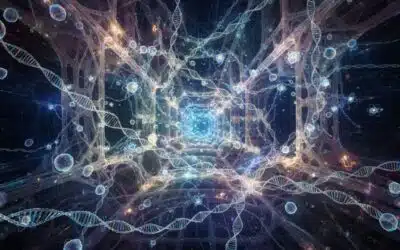The Origin of the World 2: The Display

Written by Philippe Cornu
Blog | Culture and tradition | Mind and Dzogchen | The Dzogchen basics
In this article “The origin of the world 2: the display”, Philippe Cornu addresses the notion of the display of reality for Dzogchen.
The Origin of the World 2: The Display.
About the deployment of the world from the luminous elements.
Dzogchen has its little (or big?) idea on the matter. As we have seen (The Origin of the World 1), within the original Basis of the mind there shine five spontaneous luminosities, blue, white, yellow, red and green, which in their original state are tones or notes of a pure melody, that of primordial knowledge or wisdom, always ready to unfold its symphony in the original space, manifesting the variety of appearances of the universe. What do we call “primordial knowledge” or wisdom? The intelligence proper to the Base, that is, the original information necessary for the deployment of the universe in which we live.
Let us understand: primordial wisdom is information in the highest sense, as defined in the philosophical lexicon: “a knowledge that gives form”. In other words, it is the knowledge at the origin of the universe in all its architectural complexity, just as the information contained in the genetic code is necessary for the manifestation of the various functions of the human body. It has nothing to do with the TV news… it is about the luminous intelligence of the Base.
“Thus, the primordial space and its clarity are not affected or obscured, for in their nature, all these phenomena are only spontaneously arising phantasmagoria whose empty nature remains primordially pure. Whether one perceives it as the luminous unfolding of the Base or as a world of transient and multiple objects, the unfolded universe never separates from its source, being only the dance of the primordial energy of the Base, which itself remains unaltered.”
Very well, you might say, but if this clear and primary knowledge “informs” or conceals the “perfect plan” of all phenomenal existence, why does it seem so “imperfect” to our eyes, even a source of suffering?
This is the crucial point to understand, for without this key it seems impossible to reconcile Dzogchen’s view that “everything is perfect from the beginning” with what we often experience as “ordinary citizens” of the world, immersed in this spatio-temporal universe with its imperfect manifestations. For this world does not seem to be the world of the Care Bears…
According to Dzogchen, it is our understanding of this primary information that is erroneous, and from this initial error of consciousness comes the “distortion” of the message of primordial knowledge and a whole cascade of misunderstandings and misleading perceptions of reality. Whose fault is this? Nobody’s fault but ignorance, the ‘bug’ that accompanies primordial knowledge and obscures its message, and has always done so. A Kagyupa text points to this ignorance and its effect:
Firstly, co-emergent ignorance: if we ask where it comes from, ignorance comes from grasping the Base. What is it ignorance of? It is ignorance of the nature of mind. Who then has such ignorance? It is the nature of mind that ignores itself. Since when have we been in ignorance? Since beginningless time, even before the distinction between enlightened and animated beings.
If we ask ourselves which of the two natures of mind and ignorance was here first, they co-emerge without one preceding the other. To the nature of mind we give the name of co-emergent wisdom, and to ignorance the name of co-emergent ignorance. And the place of this co-emergence is the sphere of absolute reality. Are they one or separate? They are neither one nor separate. The difference lies in the recognition or non-recognition within oneself of the nature of mind. And in what way does ignorance manifest? [It manifests itself in the power of deceptive conceptual imaginations. [1]

What happens then? Under the influence of ignorance, we are making a bad movie. A Dzogchen Bönpo text explains it very clearly:
Without having committed even the slightest evil, the animate beings of the three worlds deluded themselves by relying on the Base: as the five pure luminosities of their own manifestations emerged, due to their obtuse sensory faculties and innate ignorance, they did not recognize them as their own manifestations but apprehended them as external objects. As their proud thoughts grew in strength and coarseness, the thinking mind, associated mental factors and misconceptions emerged in them, so that they took these five luminous things from them as externally appeared objects. And so they conceived the five luminosities as fire, water, earth, air and space. [2]
This is the origin of the five elements as we know them as “bricks” of our reality: that of our physical body and that of the phenomena that surround us. With the ignorance, the initial indeterminacy splits into the subject that apprehend, “I”, and external objects, “what is other”. And the subject begins to think in terms of relations to the world: dualistic consciousness is born, with its procession of emotions, concepts, labels, etc., and the links created between subject and objects weave interactions that progressively trap us in this world in formation. In another chapter, the same text states:
There are three types of illusions: the illusion of external objects, the illusion mode of the body at the intermediate level and the illusion of the mind inside [the body]. [3]
The same text continues:
Thus was born the illusion of an exterior, like ice forming on a lake. Not understanding, the beings apprehended the illusory appearances to have their own existence and the seemingly external objects as being true. As a result, the spheres of the five pure luminosities materialized into aggregates of the impure illusory body. Three poisons, five poisons, twenty-five passions, etc., appeared, and the beings began to act according to the variety of faults connected with the gross and subtle passions, like a thirsty man drinking lukewarm water… [4]
In this way, we gradually plunge into the conditionings that make us see the world and ourselves in the light of imperfection… which is only the fruit of a simple error of interpretation! With this distorted vision appear the interdependence, the five coarse elements which compose the conditioned existence, physical space and time. A moment of unconsciousness is enough for us to fall into the painful wandering of becoming…
Whereas at the origin (in the primordial sense and not of beginning!), the Base is pure luminous space, unconditioned, timeless and not fragmented, there, due to ignorance, suddenly appear the ten spatial directions (the four main directions and the four intermediate ones, the zenith and the nadir), interdependent “conditions” between phenomena and, by this very fact, impermanence, birth and death, and thus the three times, the past, the present and the future. In this way, a multiplicity of transitory appearances is elaborated in a universe that grows in complexity and density, like water solidifying into ice.
But whatever happens, we must remember that none of this has ever really happened outside of primordial space, like the clouds that can temporarily cover the sky without affecting its nature. Thus, the primordial space and its clarity are not affected or obscured, for in their nature, all these phenomena are only spontaneously arising phantasmagoria whose empty nature remains primordially pure. Whether one perceives it as the luminous unfolding of the Base or as a world of transient and multiple objects, the unfolded universe never separates from its source, being only the dance of the primordial energy of the Base, which itself remains unaltered. But as the same text tells us:
It is because of the difference between realizing it and not realizing it that the Base presents itself as the source of beyond torment or painful wandering (samsara or nirvana). As the source of all things, it remains impartial to them, so it does not ‘produce’ the four elements, which are not developed by primary causes and are not destroyed by secondary causes. Their essence is primordially pure and their mode of appearance spontaneously present. [5]
Why is the Base not involved in this illusory display? Because unlike the phenomenal deployment of the five elements which takes place in the three times in a conditioned space, the Base always remains unconditioned and beyond the three times. It is the “fourth time”, the time of Samantabhadra, the atemporality of the three times.
[1] dPal ‘byor don grub : Chos drug nyams len gsal ba’i sgron ma, in rTsa rlung ‘phrul ‘khor, Lhasa, 1995, Tibetan text p.120 from the Si krun mi rigs dpe skrun khang’s edition. BACK
[2] In the Zhang zhung snyan rgyud, “The Oral Transmission of Zhang Zhung”, Phyi lta ba spyi gcod, The external characteristics of the View, ch. III, volume I (the external cycle). BACK
[3] idem, Phyi lta ba spyi gcod, ch. X. BACK
[4] idem, Phyi lta ba spyi gcod, ch. III. BACK
[5] idem, Phyi lta ba spyi gcod, ch. I.
More Posts
The ground of all Künshi
This article “The ground of all, Künshi” provide a better understanding of the essential words and concepts of Dzogchen.
The Four Testaments of the Vidyādharas
This article from Grégoire presents the" Four Testaments of the Vidyādharas", essential teachings from the early masters of Dzogchen.
The Story of the First Masters: Garab Dorje
“The Story of the First Masters: Garab Dorje” is the first article in a new category about the masters of the Dzogchen lineage.



